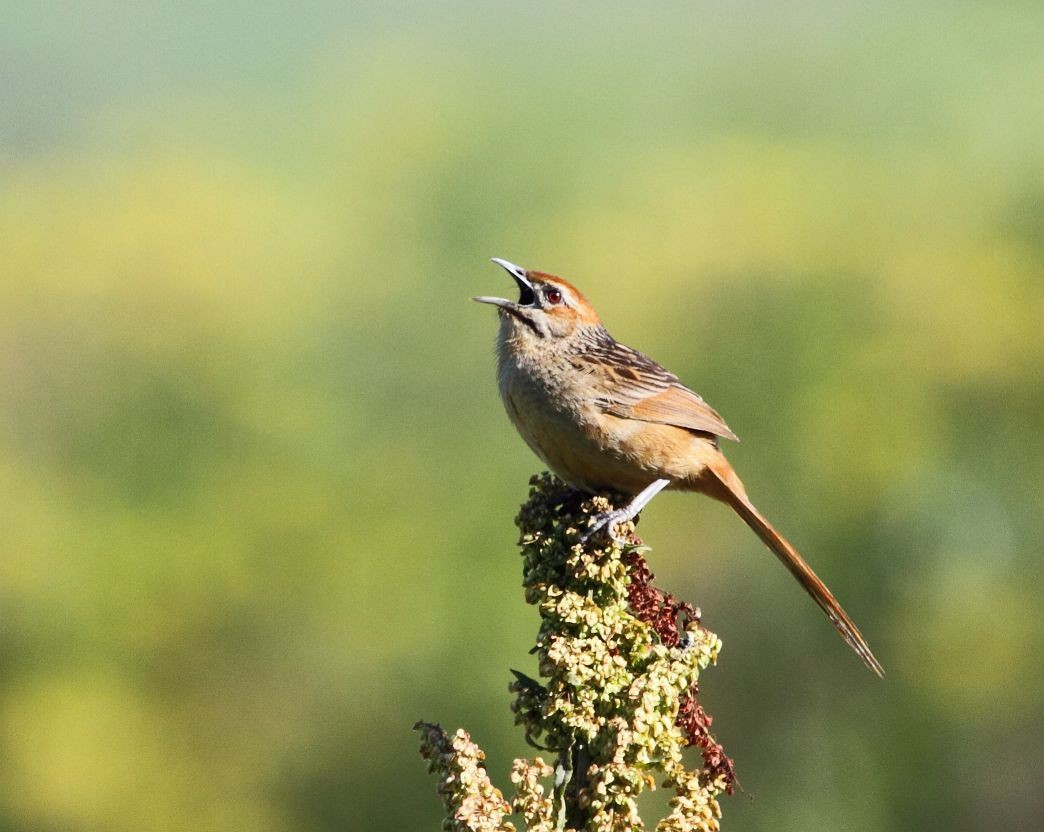Cape Grassbird
A species of Cape Grassbird Scientific name : Sphenoeacus afer Genus : Cape Grassbird
Cape Grassbird, A species of Cape Grassbird
Botanical name: Sphenoeacus afer
Genus: Cape Grassbird
Content
Description General Info
Description
The Cape grassbird is 17 to 19 centimetres (6.7 to 7.5 in) long and weighs around 30 grams (1.1 oz) Its crown and face sides are rufous, except for white around the eye, and it has black malar and moustachial stripes on its white throat. The upperparts are brown with heavy streaking and the long tail is a lighter brown while the underparts are whitish with blackish spotting. The sexes are similar, but the juvenile has a streaked cap and is duller than the adult. The song is jangling and musical, and the call is a nasal pheeeo. The long, pointed, straggly tail, chestnut cap and facial stripes are diagnostic of Cape grassbird. It is much larger than any cisticola, and the heavily streaked back and the pointed tail eliminate confusion with moustached grass warbler. 
Size
23 cm
Nest Placement
Ground
Feeding Habits
Cape Grassbird primarily consumes insects, focusing on caterpillars and larvae, complemented by grass seeds. Cape Grassbird forages on the ground, often beneath vegetation, exhibiting a dietary preference for animal protein alongside plant matter.
Habitat
Cape Grassbird thrives in a variety of grassland habitats, including coastal and mountain fynbos, rank grasslands on slopes, and river valleys. Preferring areas with an abundance of tall grasses, reeds, ferns, and interspersed shrubs like proteas, they are also found at forest edges and in coastal scrublands. They tend to avoid regions densely populated with woody vegetation. Geographically, their range extends across various elevations from sea level up to over 2000 meters in the Drakensberg region and above 1200 meters in Zimbabwe.
Dite type
Insectivorous
General Info
Feeding Habits
Bird food type
Behavior
The Cape grassbird builds a cup nest flow in vegetation. This species is monogamous, pairing for life. Its eggs have one of the slowest rates of embryonic development amongst Southern African species. The Cape grassbird is usually seen alone or in pairs, moving through vegetation foraging for insects and other small invertebrates. 
Distribution Area
The Cape grassbird breeds in southern Africa in South Africa, Lesotho, Mozambique and Swaziland with an isolated population in eastern Zimbabwe. It is a common species of coastal and mountain fynbos and long, rank grass on mountain slopes or in river valleys. 
Species Status
This common species has a large range, with an estimated extent of 390,000 square kilometres (150,000 sq mi). The population size is believed to be large, and the species is not believed to approach the thresholds for the population decline criterion of the IUCN Red List (i.e. declining more than 30% in ten years or three generations). For these reasons, the species is evaluated as of least concern. 
Scientific Classification
Phylum
Chordates Class
Birds Order
Perching birds Family
African warblers Genus
Cape Grassbird Species
Cape Grassbird 